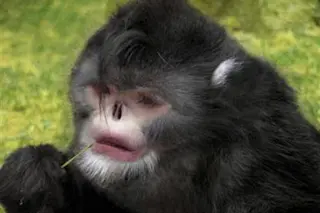The locals living in a remote Burmese forest gave wildlife biologists very clear instructions on how to find a rare species of monkey: Just go out on a rainy day, and listen for sneezes in the treetops. The snub-nosed monkey has nostrils that point up, they said, and it sneezes when rainwater drips into its nose. Even with these amazingly great directions, the biologists failed to photograph a live specimen of the Burmese snub-nosed monkey--the image at right is a digital reconstruction of what the monkey probably looks like. Still, their examination of skins and skulls in the villagers' possession provided enough evidence to declare that the monkey was a new species that had never before been described in the scientific literature. BBC reports:
Although new to science, interviews with local people in the area revealed that they knew the Burmese species as mey nwoah, "monkey with an upturned face."
...














